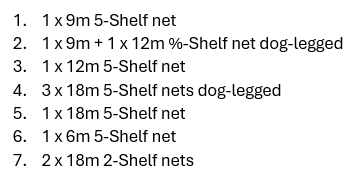Some lovely weather today and we were looking forward to a good session. To be fair, it was a very enjoyable session, and we did catch more birds than in the equivalent session last year, well, one more!
I was joined for the session by the family Childs, David and Sarah. We met at 5:30 and set the nets. The first nets were open by 5:45, with the rest of the CES nets open by 6:15. As well as the CES nets we did try out a new net ride outside of the CES area (ride 6 in the diagram below):


The non-CES net was set up in the newly planted orchard area: lots of apple trees in blossom! Lots of Willow Warblers singing and one Whitethroat. Fortunately, we did actually catch one Willow Warbler and a male Whitethroat in that net ride. Most of the other birds caught were from the ride labelled 1 on the diagram. That is unusual: normally we would have expected the ride labelled 3 to be the main catching area.
The catching was very sporadic, with multiple empty rounds. Fortunately, we had plenty to distract us. Perhaps the most interesting event of the morning was brought to our attention by a photographer who asked my opinion on a bird he had just photographed: it was a Common Sandpiper. I have seen them at Lower Moor Farm in the autumn, but never at this time of year. More interestingly, that one Common Sandpiper turned into two, who spent the next thirty minutes flying around Mallard Lake, from a base of a couple of dead trees that stick out from the main track, flying to the shore line and back again. There have been sporadic records of them breeding in Wiltshire, but is very rare. However, two together, when most will already be heading to their breeding grounds, could be a possibility. Interestingly, I contacted the Cotswold Water Park team and was told that one had been reported at the Lower Mill Estate this morning. Possibly one of the two seen today: there is about one mile between the two sites.
We also had a nice view of a Hobby flying over the site. Given how many dragonflies were emerging on the site, and how many were flying around, I was a little surprised we didn’t see the Hobby hunting. There seemed to be a lot of Downy Emerald flying around:

Downy Emerald, Cordulia aenea. There were also some early Four-spotted Chasers identified.
The list for the day was: Treecreeper 1; Jay 1; Great Tit (1); Wren (1); Dunnock 1(1); Robin 2(1); Blackbird (1); Blackcap 1(2); Whitethroat 1; Willow Warbler 1; Chiffchaff (2). Totals: 8 birds ringed from 7 species and 9 birds retrapped from 7 species, making 17 birds processed from 11 species.
There were definite highlights in the catch:

Robin, Erithacus rubecula, our first newly-fledged juvenile of the year ringed from any species. The next highlight was the previously mentioned Whitethroat. Their numbers have reduced in my catches over the last few years and we had none at Lower Moor last year:

Whitethroat, Curruca communis. I have no idea what took its interest!
Jays are always an infrequent catch: the last one caught at Lower Moor Farm was in May 2021 and the last at any of my sites was in Ravensroost Wood in July 2022. So to catch one, just about our last bird of the day, was a very pleasant surprise:

Jay, Garrulus glandarius: a delight even though it managed to rip my little finger open with one of its claws – blood everywhere, and all blood in this photo is mine!
We ran the CES for the required 6 hours, then closed the nets and took down. It really doesn’t take long when you have a crew of six to help!
























